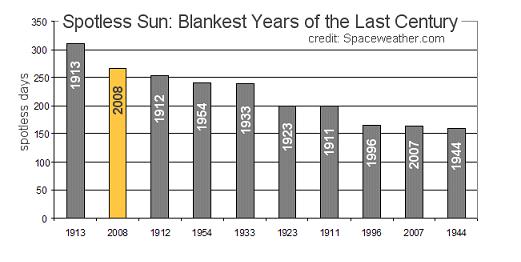
© Spaceweather.com
The year 2009 has moved into 8th place in the rankings of years with the most sunspot-free days since 1900.
The top 10 are shown in the accompanying graph; three of these have been in the past three years.
In fact, 2008, which was the quietest solar year in a century, could be bettered by 2009. If 70% of the remaining days in 2009 are sunspot free, we'll pass 2008, bumping it into 3rd place. The greatest number of sunspot free days since the year 1900 was in 1913, with approx. 320. The math shows that this record at least is safe for another year.
Another measure of solar sleep is the 10-centimeter radio flux streaming out from the nearest star to Earth. This too has been at very low levels in 2009, continuing the trend of the past two years. Much research shows that lower solar "wind" leads to more intergalactic particles reaching the earth's surface, and possibly more cloud formation. Perhaps this is how solar changes relate to Earth temperatures. More particles provide more collection sites for water vapor to condense, hence more clouds.
Some people have said that there is a correlation between this year's stone quiet hurricane season and the persistently slow solar output, but there is no empirical data to support this.
While there is probably some influence on the longer-term ocean temperatures (roughly correlated with the 11-year solar cycle) as related to solar variance, this year's tropical downturn is more likely a result of persistent wind shear over the tropics and slightly cooler than average sea temperatures.
One challenge with proving the sun has a hand in climate moods is identical to the ones facing global warming doomsayers: much of the data is based on modeling. In the case of solar research, the data is modeled from the past using available paleo-climate sources (such as ice cores, tree rings and pollen deposits), along with limited measurements from the 1600s onward.
For global warming, the data is carried forth into the future which is even less accurate, as no real data is available.
Future modeling is purely based on extrapolating present and past variations forward.
However, this certainly doesn't let mankind "off of the hook" on global climate change, but it raises the question as to how deep should trust go using purely modeled data.
The over-riding hard data pointing to something unusual outside of solar radiance variation is the degree of warming that occurred between 1980 and 2000 (the warming has at least temporarily stopped, and in fact a slight global cooling has taken place since then).
While some of this can be pinned on land-use changes at sensor sites, the rural stations have also seen a significant rise during the period, which may be most likely explained by greenhouse gas increases.
There is much to learn about the overall scheme of influences here; but it does seem odd that such a small change in the sun's energy flow to Earth (about 0.1-0.2%) could be masked by the supposed "strong signal" of human-induced climate change.
Perhaps anthropogenic climate influence is real but much weaker than presently thought? My reasoning is thus: if the industrial outgassing was the culprit in a large temperature increase in the late 20th Century, how could it be so easily masked today, when indeed carbon dioxide emissions are greater now than ever on an annual basis?
But it could be mankind's fingerprints are on the glass, at least smudged in with other factors. We would be wise to let the science continue exploring this question, and keep an open mind to the results either way.
Reader Comments
to our Newsletter